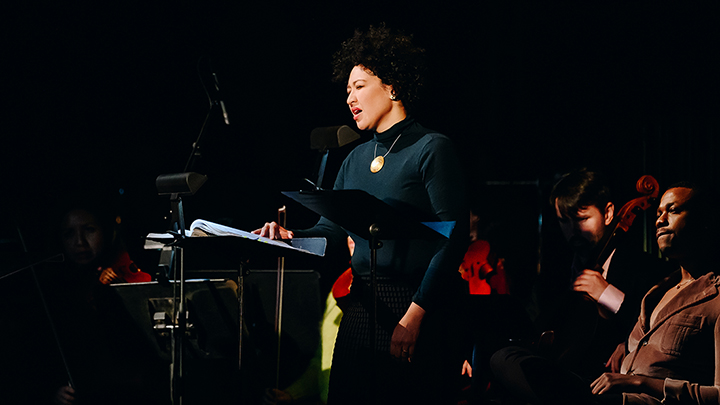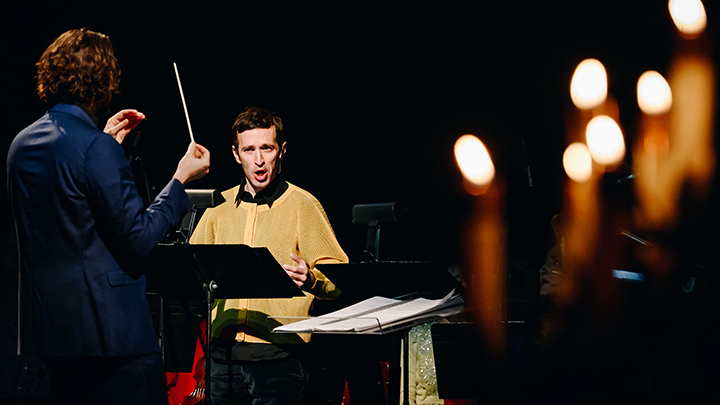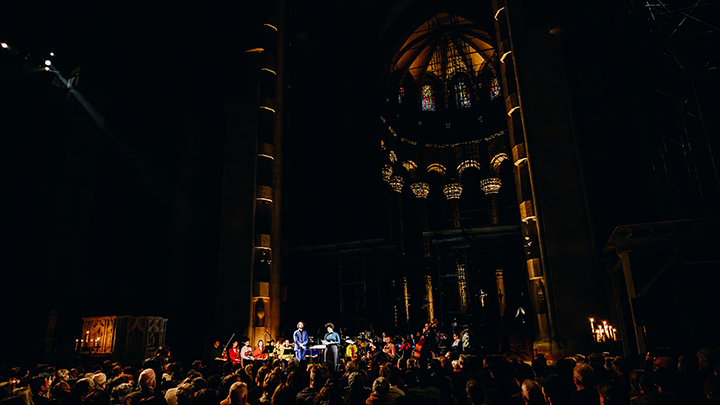
Now in its second year at the Cathedral following a cross-country tour, Nativity Reconsidered: El Niño, a chamber orchestra reduction of John Adams’s and Peter Sellars’s sprawling 2000 ‘opera-oratorio,’ still managed to draw an audience as vast and starry as the Christmas night sky, including Mark Morris, Alexei Kenney, and more clerical collars in one place than I’ve ever seen outside of Rome.
I will admit that, when I first heard of El Niño several years back, I blithely assumed that it was about the intermittently occurring weather system that warms the Pacific ocean and accordingly dumps (or withholds) rain over our western territories. And while I realized soon after that the work’s purpose was more spiritual than that, I’m not convinced that I’m totally wrong; indeed, there’s much that El Niño has that Messiah doesn’t, chief among it a sense of highly adaptable, nearly noncommittal activist abstraction that arises from largely poetical texts (arranged by Sellars) to draw together the many, often dark, themes contained in the narrative of Christ’s birth. Climate change, which threatens and shakes the earth with both authentic apocalyptic force and the gradually perceivable lilt of a rising tide, finds cognates in Adams’s varied score. It says a lot that, in this year of violence, discord, and Oppenheimer, that the score bears extreme similarities to Adams’s and Sellars’s other work of end-of-days presentiment, Doctor Atomic.
The National Oceanic and Atmospheric Administration predicts a strong El Niño this year in which “climate change can exacerbate or mitigate certain impacts related to El Niño [such as] new records for temperatures, particularly in areas that already experience above-average temperatures during El Niño.” Forces beyond our control, El Niño warns us, are coming to overwhelm. Differently from its predecessor score which will bow at the Met in the spring, Nativity Reconsidered: El Niño hearkens our focus amidst that to the premium we must place on holding fast to the intimate moments that exult us as humans, rather than disembodied forces, in order to survive. NOAA issued its first “El Niño” watch in April of this year; isn’t that, in so many words, what Advent is?
Force was probably the furthest thing from mind during Thursday’s performance. Curated by soprano, etc. Julia Bullock and presented under the auspices of the Matthew Aucoin and Zach Winokur-led American Modern Opera Company, Nativity Reconsidered inverts the scope of the original work (and shears nearly half of its material, much of it the expressly religious segments); it is quieter, smaller (adapted for a chamber orchestra, a small chorus, and a reduced number of soloists), and ordered differently. Yet whereas other Christmas works declaim the arrival of Jesus with pomp and majesty, Nativity Reconsidered speaks it into existence across a group of four soloists so in synch with each other that the effect was often one of collaborative storytelling.
Much of this coalesces around Bullock, an Adams muse, whose intellectual fixity is happily diverted from over-seriousness by a serenity and warmth that flow from her open expression and across the doggedly consistent vibrato of her voice. Bullock’s is not a columnar instrument, though it is often quite a beautifully textured one. But she has come to not only choose repertoire that speaks to her interests, but music that flatters and even accentuates the voice’s natural limitations.
In the piece’s first part, a setting of poet Rosario Castellanos’s poem “La anunciación,” the tendency of Bullock’s voice to squeeze on either side of its register break here took on a pathetic quality. In another Castellanos poem memorializing the 1968 massacre of students in Tlateloco Square in Mexico City and appended to a description of Herod’s massacre of the Holy Innocents, her disconnected high notes boomed with desperation. In Adams’s setting of the Magnificat, the voice’s limited dynamic range manifested in a moving, confiding effect.
That sense of intimacy was so well met by Davóne Tines, the bass-baritone soloist. His attack is indescribably light, conversational yet without ever stilting in gravitas. In the only explicit textual overlap with Handel’s oratorio, the Haggai prophesy “Shake the heavens,” his handsome bass-baritone was all authority with zero crude force, flowing rather than thundering in music that courts bombast.
Jasmin White, the alto soloist, has a particularly airy tone quality that stretches across their range, especially clear in the setting of another Castellanos poem, “Se habla de Gabriel.” Only countertenor Anthony Roth Costanzo, shouldering the legacy of what, in the original version of the score, are three countertenor parts that sing together, seemed tested. The English-language setting of Rubén Darío’s too beautiful poem “Los Tres Reyes Magos” cruelly cleaved his voice across its register break; if the revelation of his performance was a plangent tenor chest register, his falsetto has never sounded more curdled nor his esses more distractingly sibilant.
Christian Reif, Bullock’s husband, both conducted the ensemble and crafted the arrangement, vigorously establishing the dense chordal progressions and rhythms of Adams’s music before moving onto the next. If some of the timbral contrast and invention that drives interest in the original was missing here, you only have to wait until the spring to hear it in full at Lincoln Center. The Choir of Trinity Wall Street, too, was delicate, with particularly responsive dynamics, even for the amplified set-up (Rick Jacobsohn is the credited sound designer) across the Cathedral. Christopher Gilmore’s lighting design, which mostly included raising and lowering the lights through different parts of the space, seemed well-timed with the music, but beyond that, I’m not sure it added much.
One other addition (insofar as I can tell – there wasn’t a substantial program crediting the texts, authors, or translators available) to this year’s Nativity Reconsidered, though, proved exceptionally poignant: an portion of the Infancy Gospel of James (the first textual source to mention Mary arriving to Bethlehen via donkey):
“And when they had come within three miles, Joseph turned and saw her sorrowful; and he said to himself: Likely that which is in her distresses her. And again Joseph turned and saw her laughing. And he said to her: Mary, how is it that I see in thy face at one time laughter, at another sorrow? And Mary said to Joseph: Because I see two peoples with my eyes; the one weeping and lamenting, and the other rejoicing and exulting.”
Mary sees the very same thing as she crosses the desert from Nazareth to Bethlehem today. The disembodied, melismatic voices of Adams’s score reminds us of the ways our own essences crumble under the forces of war, of our climate, of our lack of places to dwell, either in our own homes or in our own skins. Yet instead of reproducing or finding analogies in those forces, it engages them, and us, in song.
Photos (from last year): Nina Westervelt




























Comments